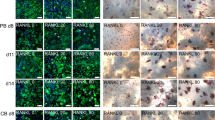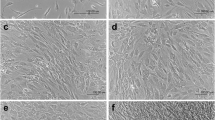Summary
Cytochemical staining of normal human bone cells in monolayer cultures for alkaline phosphatase (ALP) indicated that the cultures contained mixed-cell populations. Time course evaluations of the cytochemical staining revealed, in addition to the ALP-negative cell population, at least two subpopulations of ALP-positive human bone cells with different levels of ALP. A cytochemical method has been developed which separates the ALP-positive cells into high and intermediate ALP subpopulations. In this method, human bone cells were stained for ALP using an azo-dye method and incubating at 4°C for 10 and 30 minutes, respectively. We defined the cell population that stained positively for ALP at 10 minutes as strong ALP-positive cells, and both strong and intermediate cells were stained at 30 minutes. The intermediate cells were determined from the difference between the values at the two time points. The intra- and interassay variations of the assay, with the same investigator in blinded investigations, were both less than 10% and the interobserver variation was approximately 25%. Analysis of the distribution of ALP levels in cells with a laser densitometer confirmed the presence of at least three cell subpopulations. 1,25(OH)2D3 treatment increased the proportions of both ALP-positive cell populations, whereas TGF-beta treatment increased only the intermediate ALP-positive cell population. On the contrary, fluoride increased the proportion of the strong ALP cells, and IGF-1 had no effect on the proportions of either ALP-positive subpopulation. When the ALP-specific activity was compared with the percentage of each ALP-positive subpopulations for the cells treated with effectors, the ALP-specific activity correlated with the total ALP-positive and with the strong ALP-positive populations but not with the intermediate ALP-positive subpopulation. In summary, this study represents the first evidence that normal human bone cells in monolayer cultures contained at least two subpopulations of ALP-positive cells, and that bone cell effectors could have differential effects on each cell population.
Similar content being viewed by others
References
Wergedal JE, Baylink DJ (1984) Characterization of cells isolated and cultured from human bone. Proc Soc Exp Biol Med 176:60–69
Auf'mkolk B, Hauschka PV, Schwartz ER (1985) Characterization of human bone cells in culture. Calcif Tissue Int 37:228–235
Mills BG, Singer FR, Weiner LP, Holst PA (1979) Longterm culture of cells from bone affected by Paget's disease. Calcif Tissue Int 29:79–87
Bereford JN, Gallagher JA, Poser JW, Russell RGG (1984) Production of osteocalcin by human bone in vitro. Effect of 1,25-(OH)2D3, 24,25-(OH)2D3, parathyroid hormone and glucocorticoids. Metab Bone Dis Rel Res 5:229–234
Ashton BA, Abdullah F, Cave J, Williamson M, Sykes BC, Couch M, Poser JW (1985) Characterization of cells with high alkaline phosphatase activity derived from human bone and marrow: preliminary assessment of their osteogenicity. Bone 6:313–319
Grigoriadis AE, Petkovich PM, Ber R, Aubin JE, Heersche JNM (1985) Subclone heterogeneity in a clonally derived osteoblast-like cell line. Bone 6:249–256
Wong G, Cohn DV (1974) Separation of parathyroid hormone and calcitonin-sensitive cells from non-responsive bone cells. Nature 252:713–715
Owen M (1970) The origin of bone cells. Int Rev Cytol 28:213–238
Farley JR, Ivey JL, Baylink DJ (1980) Human skeletal alkaline phosphatase. Kinetic studies including pH dependence and inhibition by theophylline. J Biol Chem 255:4680–4686
Wergedal JE, Baylink DJ (1969) Distribution of acid and alkaline phosphatase activity in undemineralized sections of the rat tibial diaphysis. J Histochem Cytochem 17:799–806
Lowry OH, Rosebrough NJ, Farr AL, Randall RJ (1951) Protein measurement with the Folin phenol reagent. J Biol Chem 193:265–275
Burstone MS (1960) Hydrolytic enzymes in dentinogenesis and osteogenesis. In: Sognnaes RF (ed) Calcification in biological systems. Amer Assoc Adv Sci, Washington, DC, pp 217–219
Daniel WW (1983) In: Biostatistics: a foundation for analysis in the health sciences, John Wiley & Sons, New York, pp 23–29
Mulkins MA, Manolagas SC, Deftos LJ, Sussman HH (1984) 1,25-Dihydroxyvitamin D3 increases bone alkaline phosphatase isoenzyme levels in human osteogenic sarcoma cells. J Biol Chem 258:6219–6225
Bereford JN, Gallagher JA, Russell RGG (1986) 1,25-Dihydroxyvitamin D3 and human bone-derived cells in vitro: effects on alkaline phosphatase, type I collagen and proliferation. Endocrinology 119:1776–1785
Spiess YH, Price PA, Deftos JL, Manolagas SC (1986) Phenotype-associated changes in the effects of 1,25-dihydroxyvitamin D3 on alkaline phosphatase and bone GLA-protein of rat osteoblastic cells. Endocrinology 118:1340–1346
Farley JR, Wergedal JE, Baylink DJ (1983) Fluoride directly stimulates proliferation and alkaline phosphatase activity of bone-forming cells. Science 222:330–332
Wergedal JE, Lau KHW, Baylink DJ (1983) Fluoride and bovine bone extract influence cell proliferation and phosphatase activities in human bone cell cultures. Clin Orthop Rel Res 233:274–282
Ecarot-Charrier B, Glorieux FH, van der Rest M, Pereira G (1983) Osteoblasts isolated from mouse calvaria initiate matrix mineralization in culture. J Cell Biol 96:639–643
Wergedal JE, Mohan S, Baylink DJ (1990) Skeletal growth factor and other growth factors known to be present in bone matrix stimulate proliferation and protein synthesis in human bone cells. J Bone Min Res 5:179–186
Fedarco NS, Bianco P, Gehron Robey P, Termine JD (1989) Alkaline phosphatase activity in human bone cell cultures is cell cycle dependent. J Bone Min Res 4:S121
Wong GL, Cohn DV (1975) Target cells in bone for parathormone and calcitonin are different: enrichment for each cell type by sequential digestion of mouse calvaria and selective adhesion to polymeric surfaces. Proc Natl Acad Sci USA 72:3167–3171
Aubin JE, Heersche JNM, Merrilees MJ, Sodek J (1982) Isolation of bone cell clones with differences in growth, hormone responses, and extracellular matrix production. J Cell Biol 92:452–461
Pfeilschifter J, D'souza SM, Mundy GR (1987) Effects of transforming growth factor-beta on osteoblastic osteosarcoma cells. Endocrinology 121:212–218
Rosen DM, Stempien SA, Thompson AY, Seyedin SM (1988) Transforming growth factor-beta modulates the expression of osteoblast and chondroblast phenotype in vitro. J Cell Physiol 134:337–346
Author information
Authors and Affiliations
Rights and permissions
About this article
Cite this article
Matsuyama, T., William Lau, K.H. & Wergedal, J.E. Monolayer cultures of normal human bone cells contain multiple subpopulations of alkaline phosphatase positive cells. Calcif Tissue Int 47, 276–283 (1990). https://doi.org/10.1007/BF02555909
Received:
Revised:
Issue Date:
DOI: https://doi.org/10.1007/BF02555909




